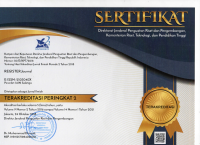Utilizing digital picture series to enhance students’ performance in writing narrative text
Abstract
Keywords
Full Text:
PDFReferences
Argawati, N. O. (2017). Teaching writing using think-pair-share viewed from students’ level of risk taking. Journal of English Education, 6(1), 109–116. https://doi.org/10.25134/erjee.v6i1.776
Aziz, F. (2019). Role of teachers in students’ classroom participation in universities. International Journal of Education and Reflection, 4(1), 46–57.
Baron, R. (2020). Students' perception of online application in speaking skill. VELES Voices of English Language Education Society, 4(2), 213–221. http://dx.doi.org/10.29408/veles. v4i2.2543
Brown, H. Douglas. (2000). Principles of language learning and teaching. A Pearson Education Company.
Bruce, J. & Marsha. W. (2000). Models of Teaching. Allyn and Bacon.
Cambourne, B. (1988). The whole story: Natural learning and the acquisition of literacy in the classroom. Ashton Scholastic.
Cohen, L., Manion, L., & Morrison, K. (2007). Research method in education. Routledge.
Creswell, J. (1994). Research Design: Qualitative and quantitative approaches. SAGE Publications.
Finnocchiaro, M. (1974). English as a second/foreign language: From theory to practice, Fourth Edition. Prentice-Hall.
Gilster. (2017). Digital Literacy. Wiley.
Gómez-rodrÃguez, L. F. (2018). Implementing critical thinking tasks to fostering English learners ’ intercultural communicative competence in a genre-based learning environment. English Language Teaching, 11(7). https://doi.org/10.5539/elt.v11n12p154
Hanadian, N. (2021). Smartphone users in Indonesia 2015 – 2025. Retrieved from http://statista.com
Halim, A., Jafar, Basri., Akil, Yahya. (2018). Task-Based Language Teaching for Writing of the Students Skill. IOSR Journal of Humanities and Social Science, 23(2), 27-34. https://doi.org/10.9790/0837-2302072734
Harmer, J. (2007). The practice of English language teaching. Cambridge.
Hidayanti, M. (2018). Implementing full day school in Indonesia: Analysing impacts on students, teachers, and school stakeholders. IAEDU-International E-Journal of Advances in Education, 4(10), 127-137. http://ijaedu.ocerintjournals.org
Kemmis, S. & McTaggart, R. (2014). The action research planner: Doing critical participatory action research. Springer.
Knapp, P. & Watkins, M. (2005). Technologies for teaching and assessing writing. University of New South Wales Press.
Mahbub, M. A. (2020). Learning English mediated by Kahoot: Insights from the Indonesian EFL instructors. Journal on English as a Foreign Language, 10(2), 246–267. https://doi.org/10.23971/jefl.v10i2.1917
Martinet, A. V, & Town, C. (1986). A practical English grammar. Oxford University Press.
Morrison, K. (1993). Literature in the ESL classroom. TESOL Quarterly.
Mudra, H. (2020). Digital literacy among young learners: How do EFL teachers and learners view its benefits and barriers? Teaching English with Technology, 20(3), 3–24.
Nasri, N. (2020). Developing EFL elementary learners ' writing skills through mobile-assisted language learning. Teaching English with Technology, 20(1), 104–121.
Nejmaoui, N. (2018). Improving EFL learners' critical thinking skills in argumentative writing. English Language Teaching, 12(1), 98–109. https://doi.org/10.5539/elt.v12n1p98
Nunan, D. (1989). Designing tasks for the communicative classroom. Cambridge University Press.
Nunan, D. (2004). Task-based language teaching. Cambridge University Press.
Paivio, A. (1991). Imagery and verbal processes. Holt, Rinehart & Winston.
Saifudin, A., Setiawan, S., & Anam, S. (2020). The implementation of task-based learning in teaching writing descriptive text to the junior high school. Linguistic English Education and Art (LEEA) Journal, 4(1), 109–125. https://doi.org/10.31539/leea.v4i1.1351
Strauber, C. B., Sorcar, P., Howlett, C., & Goldman, S. (2020). Using a picture-embedded method to support sight words acquisition. Learning and Instruction, 65(2). https://doi.org/10.1016/j.learninstruc.2019.101248
Thompson, M., Pawson, C., & Evans, B. (2021). Navigating entry into higher education: The transition to independent learning and living. Journal of Further and Higher Education, 45 (10), 1398–1410. https://doi.org/10.1080/0309877X.2021.1933400
Utami, F. S., Pabbajah, M., & Juhansar, J. (2018). The implementation of jumbled-sentences toward students’ skill in writing report text. English Review: Journal of English Education, 7(1), 115-124. https://doi.org/10.25134/erjee.v7i1.1501
DOI: http://dx.doi.org/10.30659/e.8.1.52-67
Refbacks
- There are currently no refbacks.
Copyright (c) 2023 Nichella Ayu Clarita, Ashadi Ashadi, Ulfa Amalia, Juhansar Juhansar
License URL: https://creativecommons.org/licenses/by/4.0/










